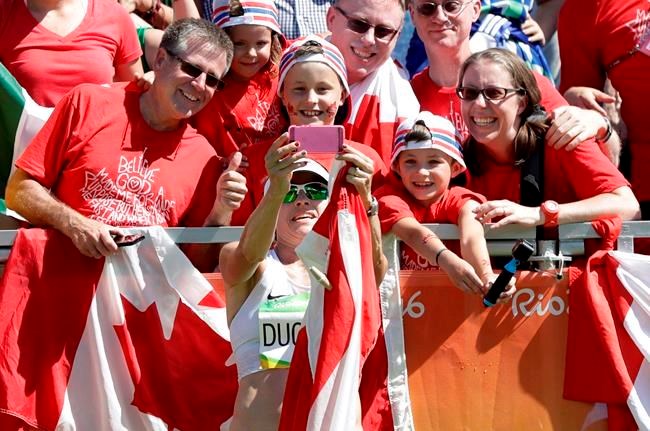Krista DuChene was only 12 kilometres into the 2013 world championship marathon in Moscow, when her legs gave way.
One of the country's most finely tuned runners was succumbing to heat exhaustion. While she recalls insisting to Canadian team coaches she was good to keep running, she'd already fallen to the pavement and was having trouble even standing up straight.
The next hour was a blurry ambulance ride. She vomited repeatedly. Russian medical officials stuffed smelling salts up her nose.
The 40-year-old from Strathroy, Ont., was one of 23 women who didn't cross the finish line on that sizzling afternoon in Russia. DuChene feels for the 5,000 runners who registered for this weekend's cancelled Montreal Marathon, but she knows all too well that crazy variations in weather are a serious health hazard in one of sport's most punishing events.
"A record number of women didn't finish the race that day (in 2013)," DuChene said. "They were going to cancel it but they decided not to.
"I was so mentally and physically ready for that race that my mind wanted to keep going but my body was failing me," she said in an interview Thursday. "Your pace slows down, your running is more difficult than what it should be. I wore a hat, and did what I could to keep the sun off my face, but I went out too hard as well. Unfortunately with the marathon, you can train in heat, and then it's cold, or you can train when it's cold and race in heat. And you have to adjust based on what the day gives you."
Race organizers cancelled Sunday's Rock 'n' Roll Oasis Montreal Marathon amid concerns about hot and humid weather. Temperatures are expected to hit 30 C on Sunday, which could feel like 38 C with humidity. The half-marathon and 10K races will take place as planned, with the half-marathon starting a half hour earlier.
The five-kilometre and one-kilometre races will take place as scheduled on Saturday.
Executive director Louis Malafarina told a Montreal news conference it was a very difficult decision — the first time the distance has been cancelled in Montreal.
"We know nothing can replace crossing the finish line of a marathon, and we sympathize with our runners who worked so hard to prepare for race day," said Malafarina, who consulted with city and health officials before making the decision.
According to guidelines set by the American College of Sports Medicine, cancellation or voluntary withdrawal of participants is recommended when temperatures are expected to be above 28 C.
Slower runners, DuChene pointed out, are most affected because they're out on the course longer and later in day.
Weather, particularly for spring and fall races when it's a virtual crap shoot, has become one of the biggest concerns for race directors. Severe weather caused chaos at a half-marathon last weekend in Copenhagen, where a runner, a volunteer and a photographer were struck by lightning. Clear skies at the starting line turned into torrential rain and hail, and runners were sloshing to the finish line in flooded streets before organizers finally pulled the plug.
The New York City Marathon was cancelled in the wake of hurricane Sandy in 2012. A freak ice storm forced the cancellation of the Dallas Marathon in 2013. And in 2007, soaring temperatures and a water shortage forced organizers to cancel the Chicago Marathon midway through the race. More than 300 runners fell ill and one runner died.
"What happened (in Chicago) was all the city's resources basically were being deployed to the race, so when you have a race of a certain size, and there's heat and medical-related issues, and you don't have enough ambulances or medical personnel, the city's resources then start getting deployed to the event, and then the entire city becomes at risk," said Charlotte Brookes, the event director for the seven-race Canada Running Series, including next month's Scotiabank Toronto Waterfront Marathon.
"(Race organizers) were working in their command centre with the city officials and they basically said 'Well, we're getting into a situation where we can't provide the appropriate public safety for everyone in the city of Chicago.'"
The ill-fated Chicago race prompted the development of the Event Alert System (EAS), which is used by most major marathons in North America. The colour-coded system — from green to black — communicates course conditions to event staff, volunteers and runners, who can see the colour-coded flags at each aid station.
Weather conditions are measured with a wet-bulb globe thermometer, which can estimate safe exposure levels to temperature, humidity, wind chill and sunlight.
At Sunday's Army Run in Ottawa, race director John Halvorsen "stood there with this thermometer device checking the temperature, because it was his job to cancel the race if it got to a certain point," said DuChene, who was a celebrity guest at the race. "Especially for those that are finishing at a slower pace, and you're getting to the point where the sun is at its peak, those are the people you have to be concerned about, not the fast ones that come in early."
Marathon cancellations are a particularly big blow because runners normally plan for just one or two a year.
"That's the unfortunate thing," DuChene said. "It can be absolutely pouring rain the day of the event, and there goes your opportunity to run your best time. It's heartbreaking at times. You've tapered appropriately, and that may just be an opportunity that you'll never get back."
Lori Ewing , The Canadian Press
